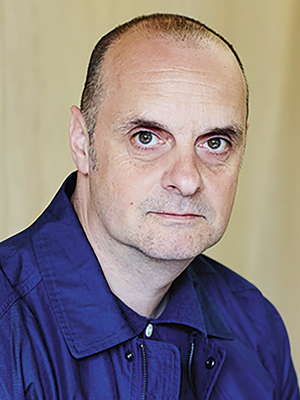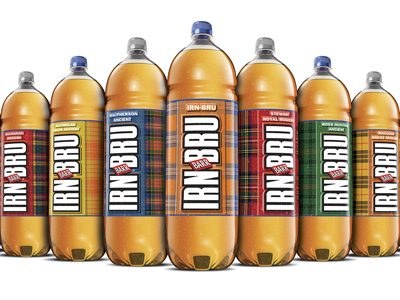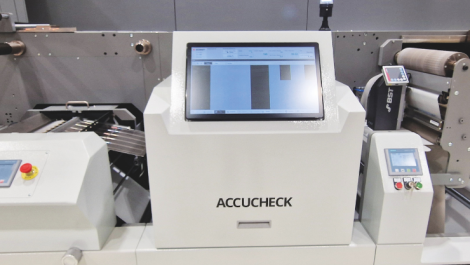The Tartan campaign for Irn-Bru
Interview with Silas Amos, founder of Design Thought. By Des King.
Converts often make the most spirited evangelists. Up until three years ago, in his role of strategy director at the jkr design consultancy, Silas Amos had barely any awareness of digital print. Then came the DBA design effectiveness award-winning campaign for Irn-Bru, which entailed labelling each of 5.5 million bottles of Scotland’s national beverage with one of 58 different clan tartans. Sales increased by 17% over a three-month period, with the brand owner AG Barr generating £34 for every one pound invested.
Amos now heads up his own consultancy, Design Thought, and regularly turns out on behalf of HP at events such as Dscoop and most recently at Interpack in Düsseldorf, as well as being a speaker on the highly influential Dieline platform. His book ‘A Bigger Spectrum’ is a must-read guide for designers looking to explore the creative marketing opportunities made possible by the use of digital print.

Silas Amos
To what extent is the print process taken into account when developing a creative brief?
Not at all, because it was so much a given. When you’re producing millions of things in litho the level at which the print came into consideration was how many colours have we got and what’s the quality like. Other than knowing the parameters of the print, it didn’t really come into my view until the back end when you hit production problems and then had to wiggle around them – and obviously we had a whole team in place to make sure that things went smoothly. They had production front of mind; we had creativity front of mind. It certainly wasn’t a matter of ‘how can we use production as a creative weapon’ in the way that we are doing now.
When did you first become aware of the possibilities afforded by digital print?
Three or more years ago when I was strategy director at jkr, I was invited to give a talk about it to a group of printers. The more I researched into it, the less I could find by way of actual examples. That made me think there was an opportunity because it hadn’t got started yet, and that got me excited thinking about all the things you could do. So I invented loads instead and showed them as if they were real to try to frighten the audience into action by pretty much saying, ‘The ship’s already left the harbour; look at all these cool things that are happening.’ It was just me taking my imagination for a walk, but there were people from HP in the audience. We got chatting and things progressed from there.
Was that the impetus behind the Irn-Bru campaign then?
HP asked, ‘Can you do for real what you just invented on stage?’ so as an exercise we developed a series of “what ifs” using brands we represented. One of them was Irn-Bru, and although we weren’t working on any actual projects at that time, we just rang them up and pitched the idea over the phone. They liked it so much so that the finished job was on a pallet ready to ship literally within weeks.
The only delay was in waiting for the Scottish referendum to take place so there wouldn’t be anything too Braveheart about it all. Even though we’d had the idea two months before the vote, with the speed at which digital print goes we still were ready to go way ahead of it. The upside of waiting until the end of the year, though, was that we coincided with Hogmanay and Burns Night, both big occasions for the Scots so the ideal time to do the promotion.
Aside from the timing, it sounds like it was really quite straightforward?
It wasn’t that difficult. Someone in the jkr office had a good idea. We had to research the tartans. HP was supporting on the technical side. I convinced the client on the phone. Our production people made it happen. Not everything’s always a struggle.
However, it does speak volumes for the challenge in this. Not everyone is as ballsy as Irn-Bru was. If you offer most organisations a solution to a problem they don’t see as being on their to-do list, they might be interested but are unlikely to take it any further. You have these almost entrepreneurial ideas; it’s amazing how few brands are willing to match that spirit.
Is the brand marketing community more switched on to digital now?
I think there’s awareness amongst designers, but there’s a slight lack in knowing how to turn it into action. If I was to be very controversial and make myself plenty of enemies in the industry, I would also suggest that advertising agencies are grasping the potential of digital more quickly than packaging design studios; maybe because they’re more practised in being conceptual. I think packaging needs to up its game a bit more.
However, I’d say that awareness is less the issue than opportunity. Partly that’s down to the client side, because no one is mandating the part of the budget that goes into what you might call ‘pack as media’. It’s not just about in store, where the onus is on achieving standout, brand recognition, navigability and shelf appeal – and all in eight seconds. Packaging has a long hearth life in the home too.
So does e-commerce represent a golden opportunity for digital print?
Yes, I think so – but logistics is the hardest part of all of this. Customisation can mean disruption to a well-ordered distribution chain. Conversely, you can think of distribution as a creative weapon. Not having to compete on the shelf, but instead being custom-designed to get to the home, opens up the way for a whole new set of criteria you might apply to how you’re presenting your brand to the consumer. It’s all about the way in which you cross their threshold, rather than screaming at them from behind a sheet of glass in a freezer cabinet in Tesco.
Also, there’s the ability to localise, personalise and topicalise that works almost better in that context. But first we need the weight of sales to justify brands bothering to do it.
Whilst customisation has undoubtedly helped drive digital print up the marketing agenda, is it likely to be a help or a hindrance going forward?
It’ll be how and why you customise that will start making a difference in any channel. After Coke did its campaign, it just seemed to be the thing to put someone’s name on the pack, but that quickly became boring. The Irn-Bru Tartan campaign was far more interesting than just putting Scottish names on the label.
For some brands it could be that their entire strategy is customisation. However, there’s a difference between giving people a little bit more affinity with a brand or diluting it by chucking conceptual crap at it the whole time. In fact, one of the dangers now with digital is that we’ll end up with a succession of ‘will this do’ creative answers coming out as opposed to something that genuinely gives people a momentary smile.
Personally, it would do my head in to go into a Tesco with 75000 SKUs in there that were all doing something zany. So we just need to temper all of this. It’s not like from this to that; it’s more like where there is a genuine opportunity to have a bit more creativity and a bit more concept and so make a connection, then do it. Right now it’s working itself out; we’ll see where it’s taken us in 20 years’ time.
With new digital technologies evolving all the time have you any thoughts on where that might be?
I think the interest is in where these things blend and how they co-ordinate. The era of tech working in silos isn’t going any further; instead it’ll all be about hybridisation, collaboration and multiple experts. Likewise, I think the days of the agency model as being protectionist and insular are numbered too. If there’s a desire to be tactical then you’d better be better at your strategy if you don’t want to get blown off course. It’s not like some new fanciful world of joy and rainbows; it’s going to need more rigour in order to harness these technologies in good ways.
What’s exciting for me is that I just don’t know how the future’s going to be. Ten years ago I’d have said it was going to be more litho. Now I don’t know, but I observe that digital is going to have a big effect on the way we all work and operate, and the things we can do. That not actually knowing quite how is why I love this; it’s just so interesting.
Read the full July issue here






